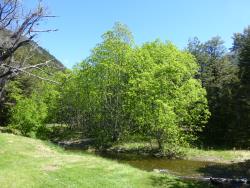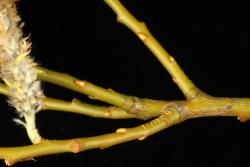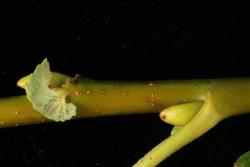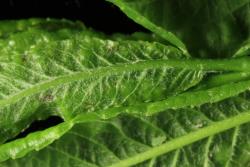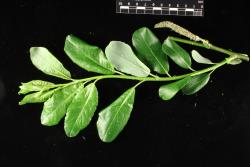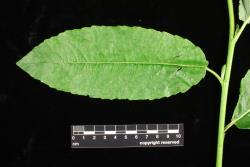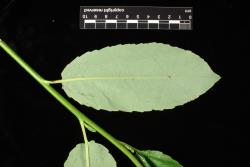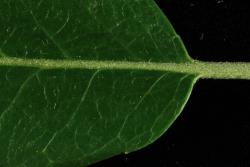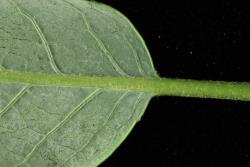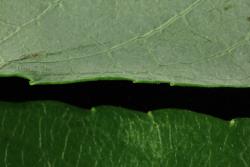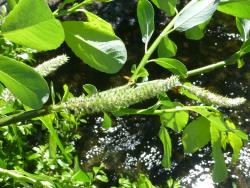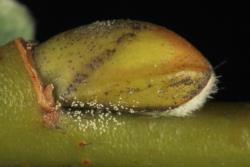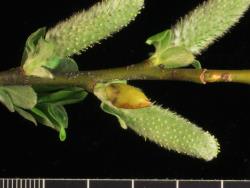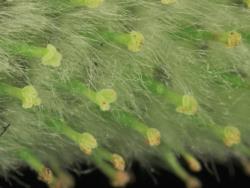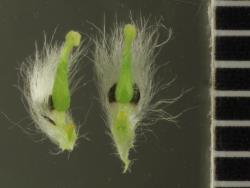- = Salix glaucophylloides Fernald, Rhodora 16: 173–175 (1914)
Shrub to 12 m, branching from the base, bark smooth, branchlets erect, branch wood without ridges. Current year's branchlets glabrous or sparsely to moderately densely villous, dark yellow to olive (UCL88–107). Year-old branchlets dark yellow to greyish red-brown (UCL46), glabrous. Flower buds 10 mm long, 4.2 mm wide, 3.2 mm deep, ovoid, 2-angled, mid-brown (UCL58), glabrous or with moderately dense short-silky hairs. Leaves alternate. Stipule 2.5 mm long, asymmetrically ovate, not persisting. Petiole 8–21 mm long, densely tomentose, glands absent, base yellow-green. Emerging leaves green, with sparse long-silky hairs on midvein, a mixture of brown and silver hairs. Proximal leaves entire. Leaf lamina 66–155 mm long, 32–70 mm wide, length to width ratio 2.0–3.0:1, narrowly elliptical to obovate, not falcate; base cuneate; apex obtuse, sometimes acuminate; leaf galls absent; margins crenate to coarsely serrate, finely revolute; upper lamina surface slightly bullate, slightly glossy, glabrous except midvein base moderately densely tomentose, stomata absent; lower lamina surface midvein and side-veins raised, netted veins raised, distinctly glaucous, glabrous or moderately densely tomentose on midvein only. Catkins emerging slightly before or coetaneously with leaves. Flowering branch 34–44 mm long with 4–5 reduced leaves. Female catkin 30–70 mm long, 11 mm diameter; catkin rachis not visible between flowers. Flower bracts 2.0–2.2 mm long, 0.6–1.0 mm wide, entirely dark brown or brown to near the bract base, flat; apex obtuse, long-silky hairs on both surfaces and margins. Male catkin 29–31 mm long, 10–14 mm diameter; catkin rachis not visible between flowers. Male nectary 1, 0.45 mm long, 0.20 mm wide, green. Stamens 2, filaments free, hairs in lower half of filament; anthers 0.9 mm long, yellow or yellow tinted with red. Female nectary 1, 0.8 mm long, 0.5 mm wide, yellow; ovary 2.8 mm long, with sparse villous hairs near the apex of the ovary and on the style base; stipe 1.7–2.0 mm long, sometimes with sparse, villous hairs; style base 0.8 mm long, style arms 0.4 mm long, unlobed, stigmatic surfaces green.
The largest flushing leaves are up to 70 mm wide, but mature leaves are smaller. Leaves are glaucous below, and side-veins project on the lower leaf surface. Hairs on leaves, petioles and branchlets are mostly silvery, but some may be brown, particularly on emerging leaves and on cataphylls below the catkin. The brown hairs may be mixed with the silver hairs or may be concentrated where hairs are dense on the underside midvein or petiole. The leaf margin is finely recurved and teeth are displaced slightly onto the upper leaf surface. Sparse, villous hairs are present at the ovary apex and style base. This feature is hardly mentioned in North American descriptions of the species (Dorn 1995; Argus 2010) but is a unique and invaluable identifying feature of female plants.
Similar in leaf size and shape to Salix reinii and S. apennina, and all three lack hairs on the underside of mature leaves. In all three the midvein and side-veins project on the lower surface. Salix apennina differs from the other two species in having smaller leaves, a less elongate leaf, and short male catkins (13–17 mm long versus 29–31 mm long in S. myricoides).
PN392 at Palmerston North is a female clone imported from Ken Stott (UK) in 1984 as "Salix himalayas", a nomen nudum. The clone was later misidentified as S. disperma Roxb. ex D.Don, a synonym of S. tetrasperma Roxb., a widespread paleotropical species of Asia. PN392 is almost indistinguishable from S. myricoides and probably is that species. Two differences are that New Zealand clones of S. myricoides usually have brown hairs on emerging leaves and cataphylls, while PN392 lacks these. Secondly, PN392 has sparse hairs at the base of the ovary while S. myricoides clones in New Zealand have similar sparse hairs but at the ovary apex.
Southern North Island (Waiohine Gorge Road 2016); Nelson (upper Motueka River 2018), Canterbury (Cave Stream 1981–2017, Waimakariri River, riverbed near Harewood 1980, Staveley 2020). Abundantly naturalised in the Craigieburn Range along Cave Stream upstream from State Highway 74, where it has spread from road stabilisation plantings on the Broken River skifield access road. Also planted more recently beside the Craigieburn skifield access road but not wild there in 2016. Both male and female plants are present at these two sites. Wild in the upper Motueka River and Waiohine Gorge Road. In Bowyers Stream below Sharplin Falls carpark (Staveley, South Canterbury) a few plants were found growing wild in the stream bed. In cultivation at Golden Downs (Nelson) and probably elsewhere.
First collection: CHR 369298, W. R. Sykes 144/80, 24 September 1980, Waimakariri River bed near Harewood, "by stop-bank in swamp, small tree ca. 8 m".
First publication: Sykes 1982 as Salix glaucophylloides.
Flowering: Early November–mid-November.
Ploidy unknown, but flow cytometry provisionally indicates PN236 is hexaploid.



